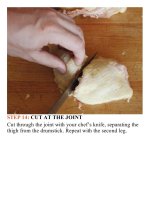The food lab better home cooking through science ( PDFDrive ) 55
Bạn đang xem bản rút gọn của tài liệu. Xem và tải ngay bản đầy đủ của tài liệu tại đây (133.85 KB, 2 trang )
Thekeydifferenceinhowthetwotypesofknives
are used is that with aWestern-style knife, rocking,
plantingthetipoftheknifeonthecuttingboardand
liftingonlytheheelendasyoufeedfoodunderneath,
is a very common motion. With a Japanese-style
knife, this is impossible—the shape of the knife
doesn’t allow for rocking. Slicing and chopping are
the more common movements, and mincing herbs
becomes a matter of repeated slicing rather than
rocking.
Theonlywaytotellwhichknivesyoupreferisto
gointoastoreandtrythemout.
1.An8-or10-InchChef’sKnifeora6-to8-InchSantoku
Knife
Thisismyknife.Therearemanyotherslikeit,butthisone
ismine.
Your chef’s knife should be an extension of your hand
and so should feel completely natural. When I’m feeling
down and I need a bit of physical support, I don’t ask my
wife to hold my hand. I don’t rub my dog on his belly.
Nope,Igotomyknifeandjustholdit.We’vespentalotof
time together. I know her every curve (I just now realized
that my knife is female) and exactly how she fits into my
hand and likes to be held, and in return, she is supportive,
loyal,andwickedsharp.
The chef’s knife is the one you’re going to be using for
95 percent of your cutting tasks, so you’d better make
damnedsurethatyou’recomfortablewithit,andhere’sthe
key: forget every review you’ve ever read. Once you get
past a certain quality level, no single knife is better than
another.That said, there are certain characteristics you can
look for, depending on your cooking style, size, and
comfort level in the kitchen. Here are a few of my basic
recommendations, but let me repeat: only you can decide
whichknifeisbestforyou.Gotoastore,trysomeout,and
mullitoverforadayortwo.Youandyourchef’sknifeare
going to have a long, beautiful, and mutually beneficial
relationship.Choosewisely.
Western-StyleChef’sKnives
• For the average cook: The 8- or 10-inch Wüsthof
Classic Cook’s Knife (about $140). This was the first
decentknifeIowned,andIstillhaveittothisday.
• Pros: It’s got a thick spine with plenty of heft, which
helps it do a lot of the slicing work for you. It has a
curvedbladethatallowsyoutorockbackandforthfor
rapid mincing. And there’s plenty of space under the
handleforyourknuckleswhenchopping.
• Cons: Some cooks may find it too heavy, and smallhandedcooksmayfindthehandleuncomfortablylarge.
• For the small-handed cook: The Global G-2 8-inch
Chef’sKnife(about$120).Stylishandfunctional.
•Pros:It’sforgedfromasinglepieceofmetal,meaning
that it’s basically indestructible. It has an extremely
sharp, precise blade and a well-balanced handle (it’s
filled with sand) to help it stay balanced even while in
motion.









